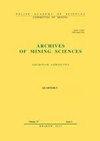矿山开挖中流体流动计算域和边界条件的定义
IF 1.2
4区 工程技术
Q3 MINING & MINERAL PROCESSING
引用次数: 0
摘要
本文章由计算机程序翻译,如有差异,请以英文原文为准。
Defining the Computational Domain and Boundary Conditions for Fluid Flow in a Mining Excavation
For underground mine workings, the shape of the computational domain may be difficult to define. Historically, the geometry models of mine drifts were not accurate representations of the object but rather a simplified approximation. To fully understand a phenomenon and save time on computations, simplification is often required. nevertheless, in some situations, a detailed depiction of the geometry of the object may be necessary to obtain adequate simulation results. Laser Scanning enables the generation of 3D digital models with precision beyond the needs of applicable cFD models. Images composed of millions of points must be processed to obtain geometry suitable for computational mesh generation. A section of an underground mine excavation has been selected as an example of such transformation. Defining appropriate boundary conditions, especially the inlet velocity profile, is a challenging issue. Difficult environmental conditions in underground workings exclude the application of the most efficient and precise methods of velocity field measurements. Two attempts to define the inlet velocity profile have been compared. The first one used a sequence of simulations starting from a flat profile of a magnitude equal to the average velocity. The second one was based on the sixteen-point simultaneous velocity measurement, which gave consistency with measurement results within the range of applied velocity measurement method uncertainty. The article introduces a novel methodology that allows for more accurate replication of the mine excavation under study and the attainment of an appropriate inlet velocity profile, validated by a satisfactory correspondence between simulation outcomes and field measurements. The method involves analysing laser-scanned data of a mine excavation, conducting multi-point velocity measurements at specific cross-sections of the excavation that are unique to mining conditions, and utilising the k - ω SST turbulence model that has been validated for similar ventilation problems in mines.
求助全文
通过发布文献求助,成功后即可免费获取论文全文。
去求助
来源期刊

Archives of Mining Sciences
工程技术-矿业与矿物加工
CiteScore
2.40
自引率
16.70%
发文量
0
审稿时长
20 months
期刊介绍:
Archives of Mining Sciences (AMS) is concerned with original research, new developments and case studies in mining sciences and energy, civil engineering and environmental engineering. The journal provides an international forum for the publication of high quality research results in:
mining technologies,
mineral processing,
stability of mine workings,
mining machine science,
ventilation systems,
rock mechanics,
termodynamics,
underground storage of oil and gas,
mining and engineering geology,
geotechnical engineering,
tunnelling,
design and construction of tunnels,
design and construction on mining areas,
mining geodesy,
environmental protection in mining,
revitalisation of postindustrial areas.
Papers are welcomed on all relevant topics and especially on theoretical developments, analytical methods, numerical methods, rock testing, site investigation, and case studies.
 求助内容:
求助内容: 应助结果提醒方式:
应助结果提醒方式:


